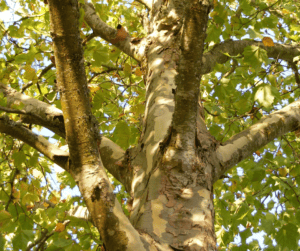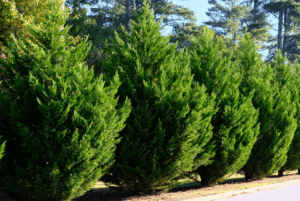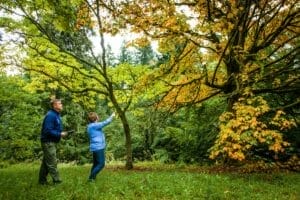 Fall is an excellent time to plant trees, but which ones? Some tree species should be generally avoided. Other trees are problematic when planted in Oregon. In this post, we list trees to steer clear of, while also giving some tips about tree care in Portland. Tree planting can be an enjoyable fall activity but making sure that you do it right (by selecting the right tree and planting it properly) is key to each tree’s success. Finally, our leading arborists talk about which trees are recommended for planting in the Beaver State.
Fall is an excellent time to plant trees, but which ones? Some tree species should be generally avoided. Other trees are problematic when planted in Oregon. In this post, we list trees to steer clear of, while also giving some tips about tree care in Portland. Tree planting can be an enjoyable fall activity but making sure that you do it right (by selecting the right tree and planting it properly) is key to each tree’s success. Finally, our leading arborists talk about which trees are recommended for planting in the Beaver State.
What Are the Most Common “Problem Trees”?
Most problems occur when the wrong tree is planted in the wrong place. When the tree’s ideal conditions for growing and establishing itself are not met, it places extra stress on the tree, which invites disease, bugs, and long-term damage. Many problems also occur when a tree grows too large for its intended spot. Trees that appear in newspaper ads guaranteeing to grow 50 feet in 5 years are best avoided.
Silver Maple. The Silver Maple grows quickly, but its aggressive roots can cause sidewalks to buckle and drains to clog. This species’ weak wood is susceptible to breaking. Although Silver Maple is adaptable to some harsh conditions, under normal circumstances it is best for firewood, not planting in your yard.
Sycamore. Sycamores are huge fast-growing trees that are usually oversized for city use. Moreover, sycamores tend to be messy, and they are susceptible to a host of diseases and fungus problems.
Siberian Elm. According to renowned tree expert Dr. Michael Dirr, the Siberian Elm may be the “world’s worst tree.” Susceptible to numerous diseases, brittle wood, and the elf leaf beetle, the American Elm is a problematic tree overall.
Bradford Pear. This tree has a poor branch structure. It grows too many branches at weak or narrow angles. Finally, the Bradford Pear’s branches tend to split as the tree reaches maturity. If you must have a Bradford Pear, plan for Portland tree services, particularly pruning, to develop proper structure.
What Are Trees We Should Avoid Planting in Oregon?
Willows. Willows are high maintenance trees that have invasive roots. As such, they are not generally recommended for Portland yards. With that said, there are 3 willows that are native to Oregon and are considered by the city of Portland to be good choices, as they are well-suited to our environment. Those three willows are the Pacific Willow (Salix lucida ssp. lasiandra), the Rigid Willow (Salix rigida var. macrogemma), and the Scouler Willow (Salix scouleriana).
 Leyland Cypress. Opinions vary on using this fast-growing cypress tree in Oregon. The downsides are clear: Leyland Cypresses require lots of trimming, care, and maintenance, and they can also be fire hazards. However, in areas with short growing seasons, such as Bend, Leyland Cypresses might not be a bad choice, given an appropriate spot.
Leyland Cypress. Opinions vary on using this fast-growing cypress tree in Oregon. The downsides are clear: Leyland Cypresses require lots of trimming, care, and maintenance, and they can also be fire hazards. However, in areas with short growing seasons, such as Bend, Leyland Cypresses might not be a bad choice, given an appropriate spot.
Ash. Ash is a species that is often considered problematic. But looking at the City of Portland’s Native Tree List, one finds the Oregon Ash (Fraxinus latifolia) as a tree that is adaptable to the city’s environment.
Native vs. Non-Native in Urban Environments
Much has been written about the use of native vs. non-native trees. Recently, discussion among city planners has focused on the use of native trees in the urban environment. Clearly, urban environments offer a different set of growing conditions than a pristine forest. As such, planners and urban homeowners must pick trees that are selected to fill a specific role, whether that be to produce shade, filter sound, or provide aesthetic beauty. Native trees and shrubs also have their place in green areas (creeks and streams located within the city limits), and as part of backyard wildlife ecosystems, which are important to a healthy city. If you are interested in learning more, check out the City of Portland’s list of Native and Nuisance trees.
Tips for Tree Care From A Leading Arborist
Fall is indeed a great time to plant, but there are a few things to be aware of as you continue. The first step is to make sure that you have done the research to select the right tree for your location. Make sure that the planting hole is plenty wide—that way, the tree’s side feeder roots will have a chance to grow before winter sets in. Additionally, be sure to water all new plantings, even if it rains. Continue to check on new trees and make sure they get the moisture they need. Make sure that you plant your tree at the right height (the root crown should meet the soil) and that the roots are not twisted or crossing (this will cause girdling). And if you aren’t sure about your trees it’s best to speak with a tree expert near you.
Urban Forest Pro Can Help!
We have several articles that discuss fall tree planting and what Portland tree services Urban Forest Pros can provide. On average, $300 will cover the costs of consultation, acquiring the tree itself, and planting by our expert crew. Since we use only premium stock that is hand-picked by our ISA-certified arborists, all of our trees are guaranteed for tree years against everything except drought and vandalism. Call us today to get started with a tree-planting project.
What Our Clients Say About Us
“Dalton and James did an excellent job. They completed the work professionally and respectfully. They cleaned up perfectly. I really appreciated them both very much and highly recommend them!! Thank you”
Kathryn D.
Rating 5/5 ⭐⭐⭐⭐⭐
See our 4.8 rating and read more of our 196 reviews on Google!

